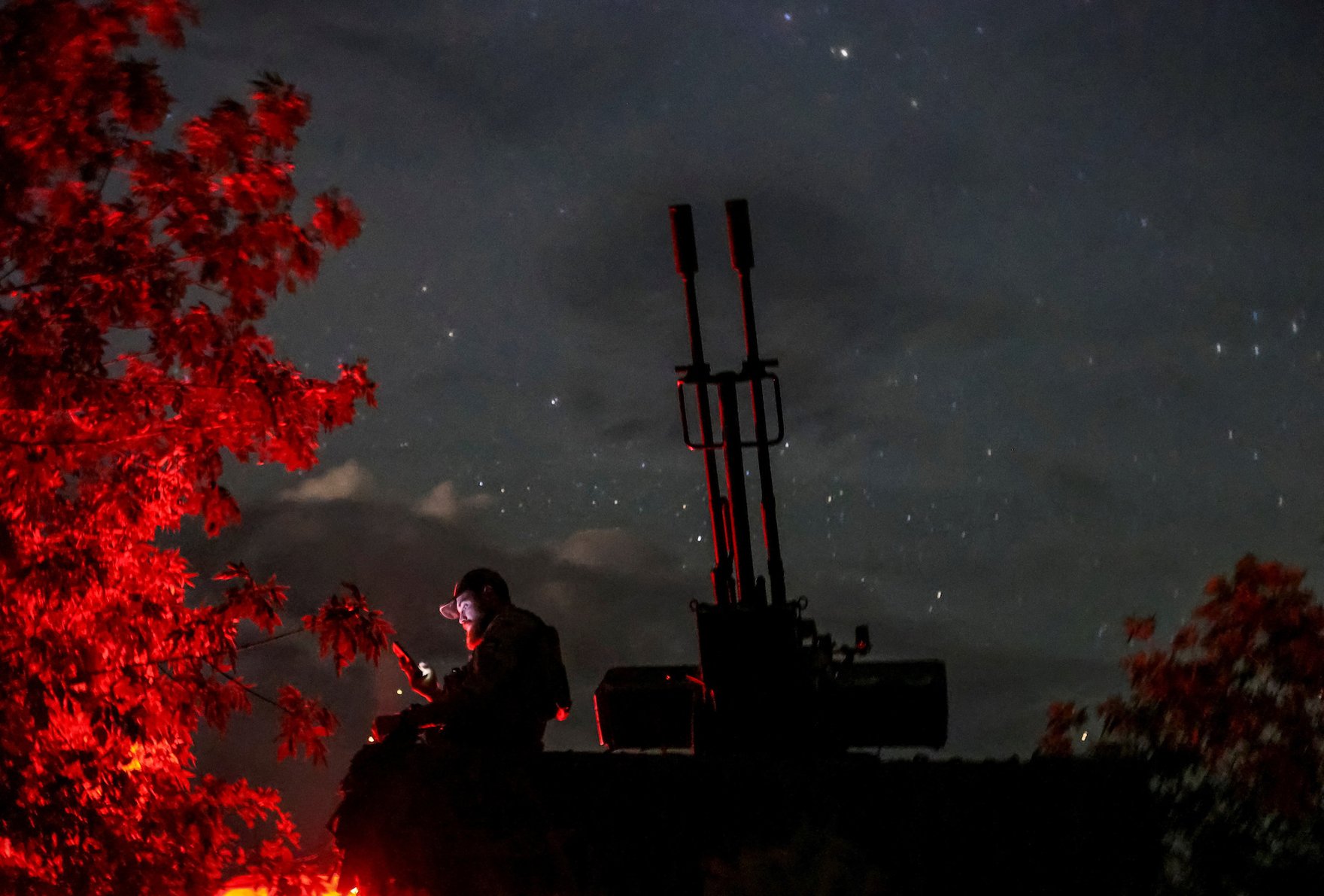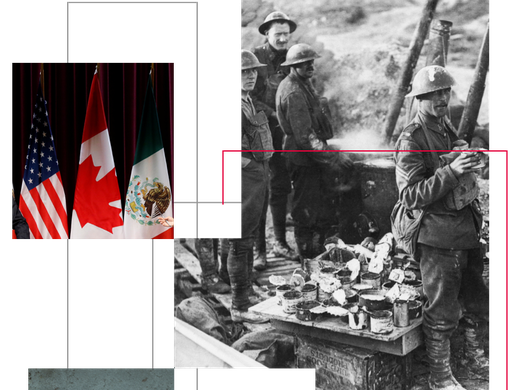“The West has to realise the era of peace in Europe is over,” Ukraine’s Minister of Foreign Affairs Dmytro Kuleba told an interviewer in April. But it’s not just Europe.
By one calculation, conflict worldwide has surged to levels not seen since the collapse of the Soviet Union. Black swan events — atypical scenarios with severe consequences — are affecting the global economy more frequently, too. Making matters even more complex is the destabilizing fallout of climate change. And then there are the ever-evolving cyberthreats and the uncertain impacts of artificial intelligence (AI). Given all this, national security has rapidly become a multilayered quagmire for policy makers.
In response, nations around the world are investing more in their militaries. But due to the nature of the threats and risks, that alone is no longer enough. Collective resilience is the goal — and that requires governments, civil society and business to collaborate in new and innovative ways. This is particularly true in liberal democracies, where international trade is integral to prosperity.
At the fulcrum of growing risk is Russia. Now in year three of its attempted conquest of Ukraine, Russia’s military has regained battlefield momentum by adopting advanced drone technology. The Kremlin — aided by Beijing — has meanwhile weathered Western sanctions. Average Russian incomes have doubled and joblessness is near record lows, thanks to a military-industrial complex that’s running at full tilt. Russian President Vladimir Putin’s appointment in mid-May of an economist to become defence minister further signals the Russian strongman is girding his nation for a prolonged conflict with Ukraine — and, by extension, the West.
It’s a war Putin and much of Russian society are confident they can win. Thousands of citizens who fled the nation in 2022 are returning. Consumers have been spared the brunt of sanctions, and multinational firms that exited Russia have been replaced by domestic copycats. Destroyed German and American-made tanks used by Ukraine are on display as trophies in city squares. The country’s main independent pollster, the Levada Center, published data last month suggesting the public’s support for the military “remains consistently high,” while its desire for peace talks has fallen.
European nations are increasingly sounding the alarm that Putin’s imperial march westward will continue if Russia succeeds in Ukraine. Several countries, including Germany, are mulling over a partial return to military conscription. These discussions have grown more intense in light of Kyiv’s struggles to mobilize and train additional troops. Ukrainian President Volodymyr Zelenskyy in April signed into law a bill lowering Ukraine’s age of conscription to 25 from 27. His government has also stopped providing consular services to hundreds of thousands of military-aged Ukrainian men living abroad.
Ukraine’s experience shows military mass clearly still matters. But it has also underscored the role broader society must play in protecting national security. Actions taken by ordinary citizens and private business, big and small, can have a huge impact. Indeed, Ukraine’s asymmetrical war effort is being kept afloat by innovative actions by civil society.
Engineers have maintained domestic power grids and energy supply amid Russian bombardment. They are moonlighting too — designing drones for Ukraine’s decentralized weapons industry. Tech professionals and coding hobbyists have blunted Kremlin cyberattacks. Accountants facilitate fundraising campaigns and the acquisition of supplies for frontline soldiers and reconstruction efforts. Mechanics ensure that firefighting and emergency services are running. Railway operators have been deemed national heroes. And reporting by journalists has helped cut through the fog of war. The sum of these actions has been to remind the world that national identity has military value.
This reinforces that, amid cascading and unpredictable crises, national resilience and solidarity matter a great deal. The North Atlantic Treaty Organization’s (NATO’s) doctrine defines resilience as “the individual and collective capacity to prepare for, resist, respond to and quickly recover from shocks and disruptions.” It credits civil preparedness as fundamental to reducing the security vulnerabilities of individual member states and boosting the overall capacity of the Western military alliance.
In May 2024, the Government of Canada’s future planning centre released a report assessing 35 society-altering disruptions that could occur within the next decade. Topping the list, in the next three to five years, is the inability of large numbers of people to distinguish fact from falsehood.
Atop NATO’s resilience matrix rest three objectives: ensuring continuity of government, maintaining essential services and enabling civil support for military operations.
NATO leaders in 2016 adopted seven benchmarks by which members could gauge their ability to withstand shocks. First, government must be able to make decisions and communicate with citizens in a crisis. Second, energy supplies should be protected, with back-up options available to mitigate power outages. Third, the uncontrolled movement of people is a given — and something authorities must anticipate. Fourth, food and water should be shielded from disruption, sabotage and contamination. Fifth, health-care systems should be well-stocked and able to cope with an abrupt mass influx of patients. Sixth, domestic communications and cyber networks must stay online. And, finally, civilians still need access to functioning transportation systems.
Attaining these goals requires that governments bring civil society and business under the umbrella of national security. Indeed, the vast majority of satellite, transportation and communications assets used by both militaries and society rely on private-sector expertise. Likewise, public awareness and citizens’ actions are needed to fend off hybrid and unconventional threats. This includes disinformation, election interference, corporate espionage, foreign infiltration of academia, transnational repression and cybercrime.
In May 2024, the Government of Canada’s future planning centre released a report assessing 35 society-altering disruptions that could occur within the next decade. Topping the list, in the next three to five years, is the inability of large numbers of people to distinguish fact from falsehood. This is followed by billionaires’ capture of political power (triggering a popular backlash) and cyberattacks on critical infrastructure. By the early 2030s, the report says, ecosystem collapse due to biodiversity loss is considered the top threat, alongside overwhelmed emergency responses and runaway AI.
Countries that thrive going forward will be those most adept at navigating changes in economics, technology and geopolitics. Sensing the dangers ahead, many governments are already launching initiatives to increase their civil preparedness.
Sweden announced in January that it would reboot its civic duty program. Suspended in 2008, the initiative focuses on providing volunteers with practical skills in municipal rescue services and navigating wartime conditions, as well as protecting the country’s energy supply. Beginning in 2018, the Swedish Civil Contingencies Agency also revived its Cold War-era practice of sending all households an e-brochure and physical pamphlet titled “If Crisis or War Comes.” It provides clear instructions for withstanding spontaneous disruptions to energy, water, food supply and telecommunications. The guidelines include how to decipher fake information about a crisis, and what to do in the event of a terrorist attack or an attack by a foreign power.
In Taiwan, non-governmental groups offer training courses on how to resist cognitive warfare — digital influence operations meant to confuse, polarize and demoralize a target population, sometimes in advance of military strikes. The Ohio Cyber Reserve is a group of volunteer commercial tech workers available on-call under the direction of the state’s national guard to combat cyberattacks. Another option is for governments to harness the growing number of commercial firms using emerging technologies to gather open-source intelligence and mine big data.
In September 2023, the Business Council of Canada released a report requesting that Canada’s spy agencies be permitted to share “timely and actionable threat intelligence” with the private sector. It’s unclear if this request has been met — although Canada may have a bigger problem on its hands. The country’s politics have been roiled by extensive allegations of foreign interference. A public inquiry is examining these claims with a final report due later this year. On June 3, an all-party parliamentary intelligence committee published claims that some Canadian lawmakers have colluded with foreign entities for personal gain. Whether and how this will be investigated remains unclear at this writing.
Either way, the damage to public trust in the integrity of Parliament, and Canadian democracy, will be considerable. That trust is crucial to collective resilience. During the COVID-19 pandemic, countries with higher levels of trust in government tended to display lower infection rates and higher vaccine uptake, due to greater adherence to public health orders. One study covering January 2020 to September 2021 suggested that, had all populations acted with the same level of trust in government shown in Denmark, global COVID-19 infections might have been reduced by 13 percent.
But while the value of trust may seem obvious, it’s also incredibly difficult to build. This has been made even harder by the splintering of shared realities and national narratives in recent years. Hyper-personalized and sensationalized content on social media actively sows distrust between different segments of society. Governments themselves have become much more risk averse in their communications. An all-encompassing 24/7 digital news cycle has officials fixated on message control to avoid mistakes that go viral.
However, basic best practices do exist. According to studies by the Organisation for Economic Co-operation and Development, the primary drivers of trust in democratic governance are reliability, responsiveness, openness, integrity and fairness. When it comes to national security, this translates to governments being more transparent about risks, both foreign and domestic. This approach runs counter to the traditional intelligence culture of tight-lipped security, but it’s no less necessary for all that.
Indeed, Michael V. Hayden, the former director of the Central Intelligence Agency, and security scholars David V. Gioe and Michael S. Goodman, recently wrote in Foreign Policy, warning the US intelligence community is facing a “crisis of legitimacy.” They blame this, in part, on the failure to properly justify renewal of section 702 of the US government’s Foreign Intelligence Surveillance Act.
This legislation, reauthorized in late April, allows for warrantless surveillance of foreign targets overseas — as well as US citizens who interact with them — for loosely defined counterterrorism purposes. This is not transparency. Instead, surrogates were left to make the argument that government surveillance can support public safety.
There are, however, signs that Western officials are adapting to this new era. Ukraine’s government has provided a master class on using digitally connected citizens to crowdsource threat information. The war has also encouraged greater use of strategic declassification by the United States and its allies. Beginning with the build-up of Russian forces prior to the full Russian invasion of Ukraine in February 2022, Western governments proactively publicized intelligence. The practice is now being extended to geostrategic competition with China. This comes with risk, such as the possible compromising of sources and collection methods, spoiling discreet diplomacy and amplifying intelligence errors or failures. It may open the door to the politicization of intelligence. But these are risks that must be run in the new era of hybrid threats.
The rise in espionage and election interference by adversarial states has led many liberal democracies to embrace foreign agent transparency registries. Mandating more regular updates to national security strategies, as the Government of Canada has promised to do, creates further opportunities to engage the public. Other nations might also look to emulate the threat intimidation guide created by the US Federal Bureau of Investigation. It’s among many methods of empowering citizens — especially those from diaspora communities — to seek help if they are facing hostile pressure from an agent of a foreign government or organized crime.
The dynamics that imperil national security today will not disappear — rather, they stand to worsen. It’s up to governments at all levels to engage with diverse elements of civil society and the private sector to devise collective solutions. Indeed, this may be the only way to ensure safety and well-being amid a rash of new and unpredictable global threats.



